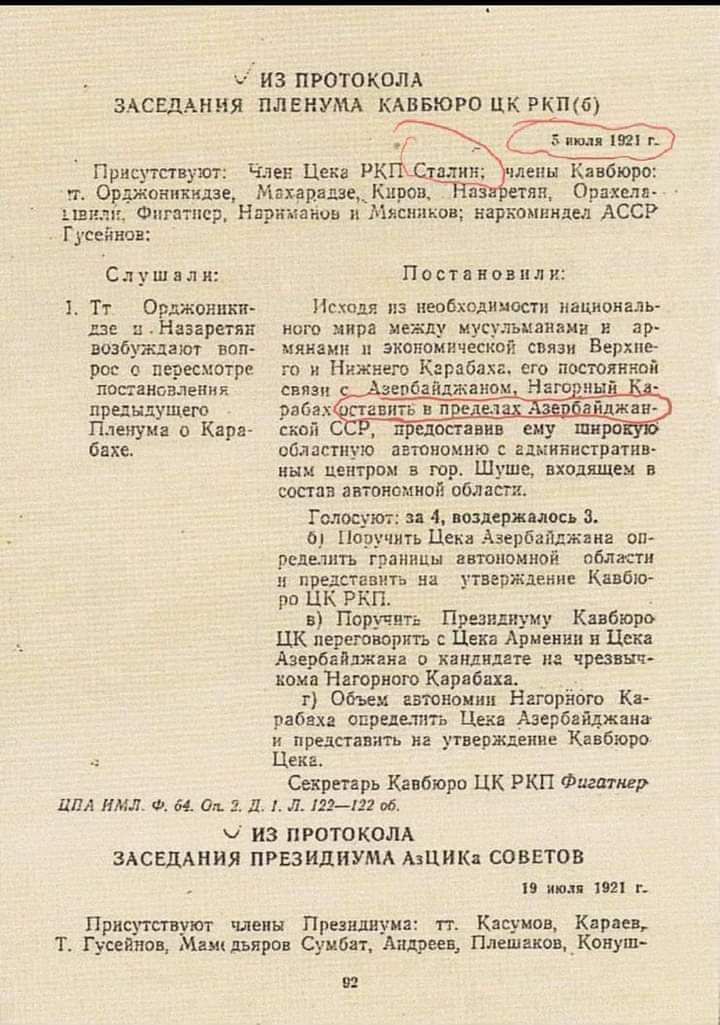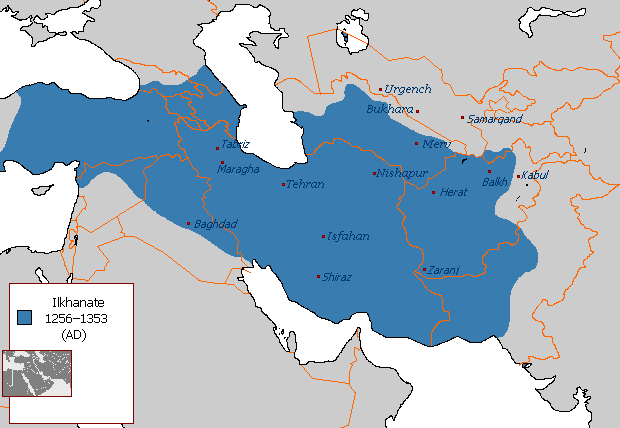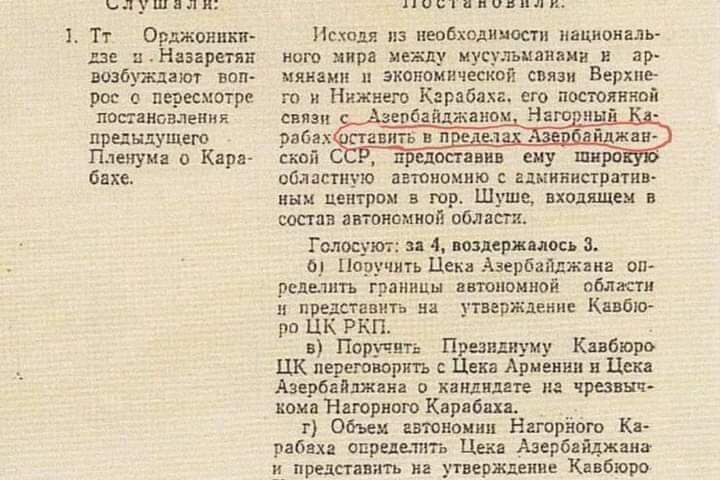Alexander Myasnikov: “It was as though Agaronyan, Topchibashev, and Chkhenkeli had Attended the Latest Plenum of the Caucasian Bureau”
In mid-August 1921, when talking on the phone to Orjonikidze, Alexander Myasnikov said that treatment of the Karabakh issue in Armenia had become more or less loyal.68
On the whole, during the first months of Sovietization, the Armenians still expected Soviet Azerbaijan to fulfill their demands.
In January 1922, at the First Congress of the Communist Party of Armenia, when asked why Nagorno-Karabakh had not been joined to Armenia, Myasnikov answered: “It was as thought Agaronyan, Topchibashev, and Chkhenkeli had attended the latest plenum of the Caucasian Bureau. Azerbaijan said that if Armenia demanded Karabakh, it would not supply it with kerosene.”69
The Caucasian Bureau was informed about the meetings of the Orgburo and Politburo of the C.C. Az.C.P. (B.) held in July 1921, the heated debates over the Nagorno-Karabakh problem, and the disagreements between the Bolsheviks of Azerbaijan and the C.C. of the Communist Party of Armenia.70
On 19 July, 1921, after discussing the decision of the Caucasian Bureau of 5 July and N. Narimanov’s trip to Tiflis, the Presidium of the CEC of Azerbaijan ruled that “Nagorno-Karabakh remains an inalienable part of Soviet Azerbaijan with the right to internal self-administration within the Soviet Constitution with the regional Executive Committee as its governing body.”71
In his report, Narimanov spoke about the administrative borders between Azerbaijan and its Transcaucasian neighbors; he also pointed out that “in view of the considerable working-class element in Shusha, the question of a Shusha City Executive Committee (in addition to the regional Executive Committee) is on the agenda. The C.C. of the C.P. of Azerbaijan should do the same in relation to the party organizations in Nagorno-Karabakh: in addition to the regional party committee, a city party committee should be set up. The relations between the regional and city Executive Committees and the Party Committees should be the same as in Baku (that is, between the Baku Party Committee and the C.C. Az.C.P. (B.).”72
On 20 July, the day after the meeting of the Presidium of the CEC of Azerbaijan and after hearing what Aligeidar Karaev had to say about the situation in Karabakh, the Politburo and Orgburo of the C.C. Az.C.P. (B.) decided to set up a commission of representatives of the people’s commissariats of internal affairs, justice, and foreign affairs to draft a constitution of the autonomous region. An excerpt from the decision was sent to S. Chvanov (People’s Commissariat for Justice), Suleymanov (People’s Commissariat for Internal Affairs), and Andreev (People’s Commissariat for Foreign Affairs). S. Adigezalov temporarily preserved his post of secretary of the Shusha Uezd Committee of the Communist Party.73
Despite the decision of the Caucasian Bureau of the C.C. R.C.P. (B.) of 5 July, all sorts of Armenian organizations remained involved in destructive actions against Azerbaijan. On 23 July, A. Karaev deemed it necessary to telegraph Narimanov and Huseynov from Shusha to inform them that “Comrade Ter-Simonyan, envoy extraordinary of Soviet Armenia, has issued an order in the Azeri, Russian, and Armenian languages, in which he informed in Gorisa that the mountainous part of Karabakh had been joined to Soviet Armenia. On the other hand, this provocation was accompanied by Ter-Simonyan appointing Musaev (Ojaggulu Musaev.—J.H.) as envoy plenipotentiary to Kurdistan. This complicated the political situation in Shusha; now it is gradually returning to normal. Ter-Simonyan wants to unite the Kubatli Uezd Executive Committee with Zangezur at all costs. Musaev disbanded the local executive committees in the Minkend area and replaced them with revolutionary committees. We should put an end to this bacchanalia and take resolute measures against Ter-Simonyan.”74
The document contains Narimanov’s resolution “To the Caucasian Bureau. Send a telegram with a request to take measures.” On 8 August, the Politburo and Orgburo of the C.C. Az.C.P. (B.) expelled O. Musaev from the Communist Party for exceeding his authority and interfering with party and Soviet work in Kurdistan.75
The decisions of the Caucasian Bureau of 5 July began to be implemented in the first days of August. On 1 August, 1921, an extraordinary Congress of the Soviets of the 2nd Part of the Shusha Uezd was held in the village of Kendhurt. L. Mirzoyan, who was invited to represent the Council of People’s Commissars, delivered a report in which he proved that economically, spiritually, politically, and ethnically Karabakh was closely connected with Baku as the center of Azerbaijan. He described the decision of the Caucasian Bureau to set up an administrative unit subordinated directly to Baku in the mountainous part of Karabakh as absolutely correct76and promised that with the establishment of an autonomy all the problems would be resolved.77
Upon his return, Mirzoyan supplied a detailed report in which he wrote, in particular, that the Karabakh issue had been created (and fanned) by top party and Soviet officials, on the one hand, an by the Armenian nationalist-minded intelligentsia, on the other.78
In their joint report on the Situation in Karabakh delivered on 8 August, 1921 at a joint meeting of the Politburo and Orgburo of the C.C. Az.C.P. (B.), L. Mirzoyan and A. Karaev confirmed this opinion. The report, which dealt mainly with party work in Karabakh, served as the basis for a new Shusha Uezd Party Committee consisting of S. Adygezalov, Makhmudbekov, Danelyants, Ataev, Safarov, Avakyan, and A. Kambarov; A. Karaev was appointed as temporary envoy extraordinary to Karabakh.79
After 5 July, it was rumored that the Armenians had been evicted from Karabakh to Armenia (L. Mirzoyan mentioned in his report that the rumors were started by nationalist-minded Armenians); gradually this “information” reached the Caucasian Bureau of the C.C. R.C.P. (B.)
It should be said that all those who were displeased with the decisions of the Caucasian Bureau of 5 July acted through Kirov (when he was elected First Secretary of the C.C. of the Community Party of Azerbaijan).
In August 1921, Secretary of the Caucasian Bureau Figatner wrote to Kirov that allegedly after the decision of the Caucasian Bureau of 5 July to keep Nagorno-Karabakh within Azerbaijan, “many Armenian villages were moved from Nagorno-Karabakh to Armenia.”80 After receiving this information, Kirov immediately asked Karaev and Mirzoyan (who were in Karabakh) to clarify it.81
Numerous facts, however, spoke of the opposite: A. Karakozov informed the C.C. Az.C.P. (B.) that nearly all the Muslims of the Jevanshir Uezd had moved away.82
The national composition of the Caucasian Bureau points to the source of the provocative information and destructive actions: in the early 1920s, out of the total number of 80 members 12 were Georgians, 28 were Armenians, 25 were Russians, 13 belonged to other nationalities, and 2 were Azeris.83
Joseph Stalin: “They Say That Fonstein, a Native of Karabakh, Represents it in the Central Executive Committee of Azerbaijan”
On 26 September, 1921, the Politburo and Orgburo of the C.C. Az.C.P. (B.) discussed the so-called Karabakh File. It was decided to ask the Caucasian Bureau to review the Nagorno-Karabakh Issue once more and to postpone its autonomy.
Narimanov and Buniatzade, on the other hand, were convinced that Nagorno-Karabakh should immediately be granted its autonomy.
A commission (Karaev, Efendiev, Stukalov, and Mirzoyan) was set up to collect the materials related to the Karabakh File; it was expected to depart for Karabakh immediately after the session of the CEC of Azerbaijan. The commission was entrusted with the task of supervising party and Soviet work in the region.84
On 6 October, the Orgburo of the C.C. Az.C.P. (B.) discussed the issue once more (without Narimanov) to obtain results as promptly as possible and instructed all the members of the commission (with the exception of Stukalov) to leave for Karabakh no later than 9 October. The Council of People’s Commissars of Azerbaijan instructed People’s Commissar for Finances Tagiev to give the commission 1 billion rubles for 4 uezds of Karabakh; People’s Commissar for Internal Affairs Bagirov was instructed to appoint responsible persons to escort the commission; People’s Commissar for Military and Naval Affairs G. Karaev had to supply 500 sets of uniforms for the Karabakh militia and 3 kg of quinine.85
On 21 October, after studying the situation in Karabakh, the commission, along with the Orgburo of the C.C. Az.C.P. (B.), gathered the executives, both Azeris and Armenians, for a conference in Shusha, Javanshir, Gubadli, and Karyagino which, after listening to A. Karaev’s report and arguing for many hours, decided that Nagorno-Karabakh should become an autonomous region.86
On 24 October, the Orgburo of the C.C. Az.C.P. (B.) discussed the commission’s report about its trip to Karabakh and the conference documents and instructed the State Political Administration of Azerbaijan to try harder to fight gangsters in Karabakh and find, in the shortest time possible, 1.5 billion rubles for four uezds to build Soviet and party work there from scratch. The People’s Commissariat for Land was instructed to dispatch commissions to Karabakh empowered to deal with land disputes.
A. Babaev replaced Sh. Makhmudbekov as Chairman of the Shusha Uezd Executive Committee, which can be described as the first step toward normalization in Karabakh.
A commission of officials of the People’s Commissariats for Land, the Navy, and Internal Affairs was set up to delimitate the borders of the autonomous part of Karabakh.87 Strange as it may seem, this happened three days after the conference attended by the members of the Orgburo and a large number of Karabakh executives had ruled that an autonomous status for Nagorno-Karabakh was inexpedient.
The decision of the Caucasian Bureau on an autonomous status for the mountainous part of Karabakh forced the Center to closely follow the relevant developments. In a letter to Sergey Kirov, First Secretary of the C.C. Az.C.P. (B.), dated 22 May, 1922, Stalin wrote the following with a great deal of sarcasm: “They say that Fonstein, a native of Karabakh, represents it in the Central Executive Committee of Azerbaijan.”88
In his letter dated 18 June, Kirov explained to Stalin that he had been deluded and listed both the members (Akhmedov, Arzanyan, Alekperov, Mamedkhanov, Mirzabekyants, and Ildrym) and candidate members (Hajibeyli, Avetisov, Khanbudagov, and Gajiev) who represented Karabakh at the CEC. In the same letter, he informed Stalin that Mirzabekyan had been transferred to the post of commissar in the Council of People’s Commissars of Azerbaijan.89
At the same time, the Center was playing into the hands of the Armenians; it tried to prevent subordination of the party organization of Karabakh to the Communist Party of Azerbaijan. On 1 August, 1922, however, Kirov and Matyushin, who headed the organizational department of C.C. Az.C.P. (B.), telegraphed to Moscow: “The territory of Karabakh is part of Azerbaijan, while its party organization is part of the Az.C.P.”90
Personnel Policy in Karabakh: More Armenians are Brought In
Kirov and Orjonikidze broke the lull which followed the decision of 5 July, 1921. They initiated a meeting of the Presidium of the Transcaucasian Territorial Committee (TCTC) of the C.C. R.C.P. (B.) held on 27 October, 1922, at which the C.C. Az.C.P. (B.), acting upon instructions, implemented the Caucasian Bureau’s decision of 5 July. The same meeting appointed Armenak Karakozov as chairman of the Executive Committee of Karabakh; another important post in Karabakh went to S. Shadunts, whom Armenia placed at the disposal of the C.C. Az.C.P.91
Three days later the leaders of the C.C. of the Communist Party of Azerbaijan, in execution of the decision of the Presidium of the TCTC, discussed the question of the Autonomy of Nagorno-Karabakh and set up a commission chaired by Agamalyoglu, with Karakozov and Sviridov as members.92
In November 1922, on the instructions of the C.C. of the Communist Party of Azerbaijan, Mirzoyan and Karaev were sent to Shusha to organize a conference of chairmen of village Soviets and secretaries of party organizations of the mountainous part of Karabakh.
After three days of discussions, the conference ruled that Nagorno-Karabakh should remain part of Azerbaijan.93
On 14 December, 1922, the TCTC brushed aside all the objections to setting up a committee on Nagorno-Karabakh; the next day, the Communist faction of the CEC of Azerbaijan and the Presidium of the C.C. Az.C.P. (B.) discussed the TCTC decision on Karabakh. A central commission was set up with Kirov, Mirzabekyants, and Karakozov as members; the same sitting set up a committee of 7 members with Karakozov as chairman.
The committee consisted of chairmen of the executive committees of the Shusha, Jebrail, and Javanshir uezds; Karakozov and the Secretariat suggested three more members (Shadunts, Tavakalyan, and Parzyan) to be approved by the Presidium.94
The Presidium instructed the CEC and the CPC to publish, within the next seven days, a decree on setting up a commission on Nagorno-Karabakh and a committee with the right to communicate independently with the Center.95 On 17 December, the Presidium of the C.C. Az.C.P. (B.) set up a committee on Nagorno-Karabakh, with Mamedkhanov, Agazade, Tavakalyan, Parzyan, and Shadunts as members.
The TCTC was requested to free Papazyan from his duties as secretary of the CPC of Armenia and Fanakolyants from his duties as secretary of the Zangezur Uezd Committee to enable them to assume their new duties as members of the committee on Nagorno-Karabakh. M. Bagirov was instructed to urgently approve the committee’s candidates with the CPC; Karakozov was asked to urgently present his estimates of future expenditures to the evening session of the Council. Strange as it may seem, the same evening, Karakozov was given a two-week leave of absence to visit Erivan.96
On the whole, in the fall of 1922, the Armenians who filled high posts in Karabakh began intensifying their contacts with Armenia. On the other hand, in the early 1920s, certain Armenians who fought openly or behind the scenes to detach Karabakh from Azerbaijan were invited, one after another, to move first to Baku and then to high posts in Karabakh.
In the first days of 1923, Sergey Kirov, Secretary of the C.C. Az.C.P. (B.), asked TCTC head Myasnikov to ask the C.C. of the Communist Party of Armenia to send Tavakelyan and Manutsyan to Baku so that they could promptly join Karakozov in Shusha.97
On 23 January, 1923, Kirov, this time with Karakozov, asked A. Ionisyan, Secretary of the C.C. of the Communist Party of Armenia, to send Tavakelyan, Akopyan, Aydynyan, Vartanyan, Akhtynsky, and Manutsyan to Karabakh.98 A week later, Kirov sent a similar telegram to Myasnikov accompanied with the following words: “Without more people, it is impossible to organize proper work in Karabakh.”99
It should be said that, in May 1921, Armenia appointed Akop Ionisyan as its representative in Nagorno-Karabakh.
The list was obviously compiled by Ionisyan and Karakozov during his two weeks in Erivan.
This meant that from the very first days of 1923 the trend toward greater reliance on the party and Soviet officials from Armenia who, one after another, received high posts in Karabakh became obvious; this tipped the balance in favor of the Armenians.
After a while, the Armenians entrenched themselves in Nagorno-Karabakh.







